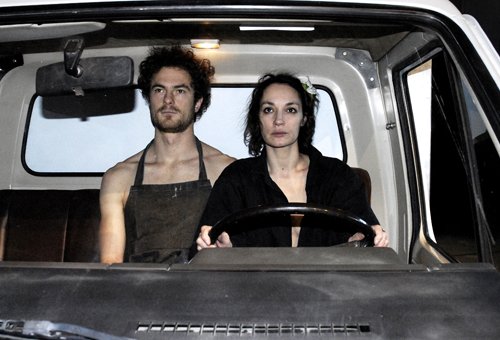
Don’t know if I like Hijikata. Believe rather in the desire to carry his writings, which themselves carry his dancing. His dancing, his butoh, his emotions are to be found already in the lame territories, the feelings of defeat, « the baby’s head at the bottom of my mud » that he lays down on paper. Which perhaps radically saves us the necessity of performing, re-performing, his dance.
« While being glad of possessing one’s own head and one’s four limbs, to think nevertheless that one would have wished to be born impotent once and for all ; because it is only when such a desire comes to you, that the first step in dancing is finally achieved. »
Not that it would be a disgrace to try to remake the butoh. (There is surely a butoh left to invent : the re-butoh ? _rebuffing, that’s what the new butoh should be…)
But my idea is that we will not make butoh from these haunting texts, because they already carry the butoh inside them. Straw, mud, deformity, guts, everything is there… The work shall be done from underneath, on the sides. We shall dig up the thought of a tremendous artist so that he leaves us entirely to our own madness.
Let the strength of his writings, which must be as if given to read, give us freedom within the very gesture of carrying them. Let us not draw our inspiration from Hijikata, let us not construct a show which proceeds from his writings, let us not really make any « mise-en-scène ».
We wave a banderole at arm’s length but they threaten to drip on us, to shed their stains. And perhaps this is why I’m not sure I can like Hijikata : he looks dirty, dead, impotent, a virgin, and obscene.
Boris Charmatz
Surrounded by lashing nudes, the dance creator wastes away tremendously. My chest, by dint of immersing its scraggy ribs in the sewer canals, has become cluttered with the wrecks of the time. To prevent it rusting, I oiled it copiously, before settling down to my job for endless days. Far from this chest and its painful convalescence, I was offering myself the pleasure of sunbathing in the theatres. Inside shelves of a well watched over mortuary, the gaze has been threading its way upon the present generation, whose soul couldn’t under any circumstances live only on the possessions received in legacy. Meticulously striding over Tokyo — where that generation which has conceived the eyes of the hands, is not inevitably extinct — I come to the material. All I had to do was to pick it up among a youth busy here rubbing in a galvanization shop, there squatting in a garage. I look at the hands. A movement of raw particles arises from them. The spinal column bends slightly forwards. A dance rushes down its slope. For just one unhappy gaze, one risks being changed into gelatin. Burning heads. The constricted vengeance of a cold button has bowed its forehead very slightly; the material must first be a lover. I move closer. The smell produces between the boys and me an almost ascetic balance; in general, all those bodies extended like an umbrella’s branches to catch things falling, all those crooked, brittle bodies, stiffened by sacrifice, give in various ways priority to the quasi trademarked lines of their circle of twenty years old, instead of all the attractive figures. In the boundless Tokyo there are some bodies to burst.
Tatsumi Hijikata, From Inner Material, Translated by Patrick De Vos
Running time: 1h10 approx.
Jeanne Balibar, Boris Charmatz
Lights: Yves Godin
Lights and video technician: Eric Houllier
Set conception: Alexandre Diaz / Dominique Bernard
Technical direction: Frédéric Vannieuwenhuyse
Set construction: Artefact
Sound: Olivier Renouf
Sound control: Jacques Marcuse
with the collaboration of Françoise Meslé pour Jacana wildlife studio
Texts: Tatsumi Hijikata
Translation: Patrick De Vos
Helmet performance devised and passed on by Gwendoline Robin
Production direction: Sandra Neuveut, Martina Hochmuth, Amélie-Anne Chapelain
Production: Association edna; Musée de la danse / Centre chorégraphique national de Rennes et de Bretagne directed by Boris Charmatz, is supported by the French Ministry of Culture and Communication - the Direction régionale des Affaires Culturelles, the city of Rennes, the regional Council of Brittany and the General Council of lle-et-Vilaine.
The Institut français regularly contributes to the international touring of the Musée de la danse-Dancing Museum.
Coproduction: Le Théâtre de la Ville Paris / Festival d’automne à Paris, co-production with the CNDC Centre national de danse contemporaine Angers and the Nouveau Théâtre d’Angers centre dramatique national des Pays de la Loire, as part of their residence programme for dance/theatre, La Ménagerie de Verre-Paris as part of its studio receptions, deSingel Anvers,
with the kind authorization of the Buto Sôzô Shigen, Tokyo
with the support of the ADC in Genève-Switzerland, the Dampfzentrale in Bern-Switzerland, the Gessnerallee in Zurich- Switzerland, the Tanzquartier in Wien-Austria and Cultures France
Thanks to: Marie-Thérèse Allier, Frédéric Bélier-Garcia, Lalou Benamirouche, Patrice Blais et Raoul Demans, Patrick De Vos, Myriam De Clopper, Marie Collin, Emmanuelle Huynh and all the tream of the CNDC of Angers, Sima Khatami, Isabelle Launay, Aldo Lee, Frédéric Lormeaux, Barbara Manzetti, M. Marlhin (DPI society), Takashi Morishita, Jean-Philippe Varin, Gérard Violette and Angèle Le Grand.
First production September 24th 2008, at the CNDC, Angers
Cover picture: © Fred Kihn / La danseuse malade, Le Quai Angers, 2008



